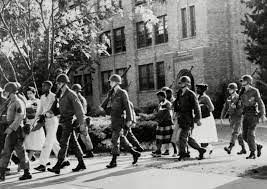On September 25, 1957, a group of nine African American students, known as the "Little Rock Nine," made history as they attempted to integrate Little Rock Central High School in Arkansas. This event marked a pivotal moment in the civil rights movement and highlighted the ongoing struggle for desegregation and equal rights in the United States. The Little Rock Nine consisted of Ernest Green, Elizabeth Eckford, Jefferson Thomas, Terrence Roberts, Carlotta Walls LaNier, Minnijean Brown, Gloria Ray Karlmark, Thelma Mothershed, and Melba Pattillo Beals. These brave students were selected to enroll at Little Rock Central High School as part of the desegregation efforts following the Supreme Court's landmark ruling in Brown v. Board of Education in 1954, which declared segregation in public schools unconstitutional. However, their attempt to attend school on September 25, 1957, was met with hostility and resistance. A mob of white protesters, including parents and students, gathered outside the school, shouting racial slurs and threats. The Arkansas National Guard, under orders from Governor Orval Faubus, was deployed to prevent the African American students from entering the school. The Little Rock Nine faced immense challenges and obstacles during their time at Central High School. They endured verbal and physical abuse, harassment, and discrimination from white students and community members. Despite the hostility, they displayed remarkable courage and resilience, continuing to attend school and pursue their education. The events at Little Rock Central High School drew national attention and sparked a heated debate about racial segregation and civil rights. The federal government, under President Dwight D. Eisenhower, intervened to protect the rights of the Little Rock Nine. On September 24, 1957, President Eisenhower ordered federal troops, the 101st Airborne Division, to enforce the integration of the school and ensure the safety of the African American students. The presence of federal troops allowed the Little Rock Nine to enter the school on September 25, 1957, under the protection of armed forces. However, their struggle was far from over. They continued to face hostility and discrimination throughout the school year, with some of the students facing expulsion and others enduring harsh treatment from both students and teachers. The courage and perseverance of the Little Rock Nine in the face of adversity had a profound impact on the civil rights movement. Their bravery brought national attention to the issue of racial segregation and galvanized support for desegregation efforts across the country. The events at Little Rock Central High School led to increased public awareness of the injustice of segregation and helped pave the way for further progress in the fight for civil rights. The legacy of the Little Rock Nine endures to this day. Their struggle and sacrifice serve as a reminder of the importance of equality, justice, and the ongoing fight against discrimination. The courage of these nine students helped shape the course of American history and contributed to the dismantling of segregation in schools and other public institutions. The Little Rock Nine's efforts also highlighted the power of education as a catalyst for social change. By bravely pursuing their education in the face of adversity, they demonstrated the transformative potential of equal access to quality education. On September 25, 1957, the Little Rock Nine took a significant step towards breaking down racial barriers and fighting for equal rights. Their determination and resilience continue to inspire generations and serve as a reminder of the ongoing struggle for justice and equality in the United States.
25 Sept, 1957 U.S.A. Little Rock Nine
